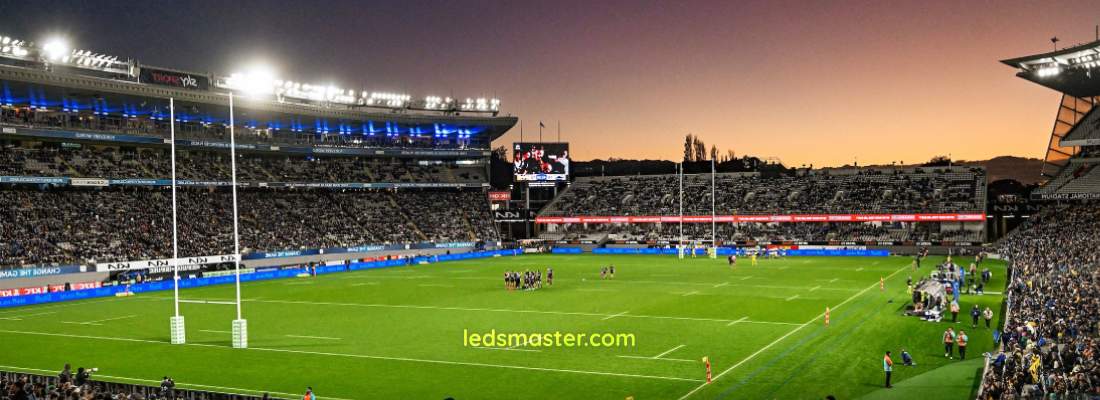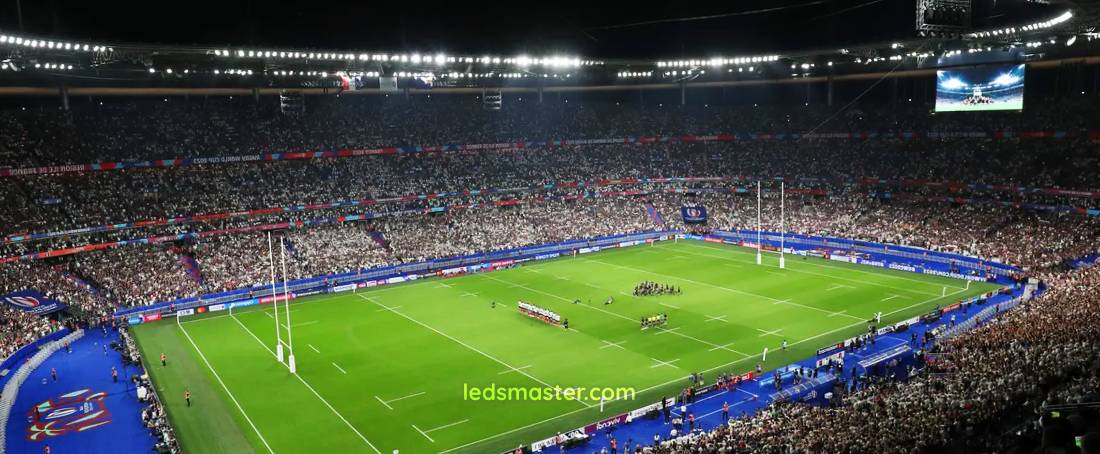From weekend matches to high-profile tournaments, the right lighting transforms the field into a vibrant arena, ensuring every play is highlighted perfectly. Achieving this involves balancing brightness, uniformity, and color accuracy to meet specific competition standards.
Get your complimentary lighting design today
Lighting rugby fields is a complex task that requires a holistic approach. It involves various factors including lumen output, beam angle, color temperature, and the power of the rugby field lights. Additionally, the layout of light poles plays a crucial role in achieving effective illumination. Given that each stadium has unique requirements, a one-size-fits-all lighting layout is impractical. This guide provides a detailed overview of the key considerations for lighting rugby fields effectively.
Table of Contents
ToggleTo begin, consider the standard dimensions of a rugby field, which typically measures 120 meters in length and 70 meters in width. However, these dimensions may vary slightly based on the level of competition and local regulations. The field’s size plays a significant role in determining the number and positioning of floodlights required for adequate illumination. Larger fields necessitate more powerful lighting systems to achieve uniform brightness across the playing area.

Floodlights are typically mounted on high mast poles to ensure they are elevated enough to provide comprehensive coverage of the field. The configuration of these poles can vary, with options for either four or six poles. The choice between these setups depends on the dimensions of the field and the desired lighting effect. Properly designed layouts are crucial for minimizing shadows and enhancing visibility for all participants in the game.
The lights should be angled in such a way that they direct the beam toward the field’s surface, providing consistent illumination throughout the playing area. Achieving optimal lighting requires careful consideration of the surrounding geography, as well as any structures that could obstruct light distribution.
Furthermore, the arrangement of floodlights should allow for uniform light distribution while preventing glare. This is especially important for night games or matches played under artificial lighting. A thorough lighting design can eliminate potential dark spots or overly bright areas, enhancing the overall playing experience for athletes, officials, and spectators.
A aspect of rugby field lighting is ensuring the appropriate brightness levels, measured in lux. The RFU guidelines provide recommendations for the minimum lux levels required for various levels of play. These guidelines categorize illumination needs based on the type of competition and the importance of the match.
For recreational and general commercial use, the RFU recommends lux levels ranging from 250 to 300 lux. This level of illumination is typically sufficient for casual play and training sessions in community parks or local clubs. However, as the level of competition increases, so do the lux requirements.
In amateur or recreational contexts, a lighting level of 200 to 300 lux is generally acceptable. For professional matches, the RFU suggests a minimum of 300 to 500 lux. As we progress to national competitions, the lighting requirements rise significantly. National matches typically necessitate lux levels between 1000 and 1200, with at least 1000 lux required on vertical surfaces, such as goalposts and players.
For the highest levels of competition, such as international or world-class tournaments, the lux requirements soar to between 1500 and 2000 lux. This includes a minimum of 1000 lux on vertical planes to ensure optimal visibility for players and officials. The increased brightness not only enhances the viewing experience for spectators but also ensures that players can perform at their best, even during high-stakes matches.
Another vital component of rugby field lighting is achieving uniform illumination across the entire playing area. Uniform lighting minimizes shadows and ensures that all parts of the field are equally visible, which is essential for player safety and performance. For a standard rugby field measuring 120 by 70 meters, the total lumen requirement is approximately 2,100,000 lumens. This translates to around 15,000 watts of LED lighting needed to achieve the desired brightness levels.
Lighting uniformity is typically expressed as a ratio, with the common standard for sports fields being around 0.6. This ratio indicates that the minimum illumination level in the darkest areas of the field should be at least 60% of the average light level across the entire field. However, for professional or international matches, the uniformity ratio should increase to between 0.7 and 0.8. Achieving this level of uniformity often requires additional floodlights or taller poles to disperse the light effectively.
Designing for lighting uniformity can be facilitated by utilizing advanced lighting design software, such as DIALux. These tools can simulate different lighting configurations, allowing lighting engineers to optimize the setup for uniformity, brightness, and coverage. By conducting thorough analyses and making informed decisions about light placement and type, it is possible to create an environment that enhances the overall playing experience.
Color temperature is a factor to consider in field lighting design. It refers to the hue of the light emitted by the lamps and is measured in Kelvin (K). The three main types of color temperatures are cool white, warm white, and natural white light. For rugby fields, natural white light with a color temperature around 5000K is often regarded as the most suitable option. This temperature closely mimics daylight, which can enhance visibility and player performance.
Natural white light helps players and officials see the ball and field markings more clearly, improving the overall experience of the game. In contrast, warmer or cooler light may distort colors and make it difficult for players to distinguish between different objects on the field. Therefore, selecting the appropriate color temperature is essential for creating a conducive playing environment.
The color rendering index (CRI) is another factor that influences the effectiveness of field lighting. The CRI measures a light source’s ability to accurately reproduce the colors of objects in comparison to natural light. A higher CRI is preferable for sports lighting, as it allows players and spectators to see the true colors of the field and rugby balls.
High CRI values improve the overall viewing experience, making colors appear more vibrant and consistent with daylight conditions. This is particularly relevant for rugby, where accurate color representation can affect players’ perception of the game and their interactions on the field. Ensuring that the lighting has a high CRI contributes to a more immersive and enjoyable environment for everyone involved in the game.
One of the most notable advantages of LED lights is their exceptionally long lifespan, which can reach up to 100,000 hours. This longevity translates to fewer replacements and maintenance interventions over the life of the lighting system, making LED technology a cost-effective solution for rugby field lighting. Recent advancements in LED chip arrangements and heat dissipation have further enhanced performance, allowing for better management of heat accumulation.
Effective heat management is maintain the lifespan of lighting fixtures, as excessive heat can lead to premature failure. By using well-designed LED fixtures with appropriate cooling systems, operators can ensure that their lighting remains reliable and efficient over time.
In addition to their longevity, LED high-mast lights are significantly more durable than traditional lighting options, such as metal halide, high-intensity discharge (HID), or high-pressure sodium (HPS) lamps. They are specifically designed to withstand challenging weather conditions, including heavy rainfall, strong winds, and extreme temperatures, even down to -40°C.
The IP66 waterproof rating of LED lights ensures that they remain operational in severe weather conditions, providing reliable performance throughout the seasons. This durability is particularly beneficial for rugby fields, which may be subject to varying weather patterns and environmental factors.
LED floodlights are recognized for their impressive energy efficiency. For instance, a single LED floodlight used on a rugby field can produce between 150,000 and 300,000 lumens while consuming only 1000 to 2000 watts of power. In comparison, traditional metal halide lights would require between 5000 and 10000 watts to achieve similar brightness levels.
This energy efficiency not only reduces the overall energy consumption of the lighting system but also leads to substantial cost savings. For example, utilizing 30,000 watts of LED lighting for a professional rugby field could result in a daily operational cost of approximately $24, translating to around $720 monthly. The savings on energy bills can be reinvested into other areas of the club or organization, enhancing overall operational efficiency.
LED lighting systems offer a wide variety of beam angles, which allows for greater flexibility in achieving the desired lighting uniformity. Beam angles can range from wide options, suitable for close-range illumination, to narrow options, ideal for long-distance lighting.
To meet specific uniformity requirements of 0.7 to 0.8, a combination of different beam angles may be needed throughout the lighting design. Properly selecting beam angles is essential to ensure that the light reaches all areas of the field effectively. This flexibility allows lighting engineers to create tailored solutions that address the unique characteristics of each rugby field, resulting in optimal illumination.

The installation process of lighting systems for rugby fields should be approached with careful planning and consideration. The positioning of poles, the orientation of fixtures, and the electrical infrastructure must all be properly designed to maximize efficiency and performance. Collaborating with experienced contractors and lighting specialists can facilitate a successful installation process.
Regular maintenance ensure that the lighting system continues to operate effectively. Scheduled inspections and timely repairs can prevent unexpected failures and prolong the lifespan of the fixtures. Additionally, staying current with technology advancements and upgrades can enhance the efficiency and effectiveness of the lighting system over time.
As sustainability becomes increasingly relevant in sports and recreation, the environmental impact of lighting systems must also be addressed. LED lighting is inherently more environmentally friendly due to its energy efficiency and extended lifespan.
Incorporating renewable energy sources, such as solar panels, can further reduce the carbon footprint of rugby field lighting. Solar panels can generate electricity during daylight hours and store excess energy for nighttime use. This approach not only contributes to sustainability efforts but also leads to significant cost savings over the long term.
Rugby fields serve as more than just a space for sporting activities; they often act as community hubs that bring people together. Ensuring that lighting is adequate for recreational use during evening hours encourages community engagement and participation. Well-lit fields can host training sessions, local matches, and community events, fostering a sense of belonging and promoting healthy lifestyles.
Creating a well-designed lighting system that meets the needs of the community enhances the overall experience for all users of the rugby field. Engaging with players, coaches, and community members can provide valuable insights into how the lighting can be improved or adjusted to better serve the needs of the community.
Understanding the specific needs of the community can guide the design of lighting systems that enhance safety, performance, and enjoyment. Collaborating with community stakeholders to gather feedback can ensure that the lighting meets expectations and addresses any concerns related to visibility and safety.
Rugby field lighting involves numerous elements that must be considered to create an optimal playing environment. The integration of technology, such as LED lights, alongside adherence to RFU standards, contributes to effective illumination and improved player experience.
By addressing field dimensions, brightness requirements, uniformity, and the advantages of LED technology, rugby organizations can ensure well-lit environments that foster safety and performance. Collaborating with lighting experts and engaging with the community can lead to tailored solutions that meet the unique needs of each rugby field, ultimately enhancing the enjoyment of the sport for players and spectators alike.